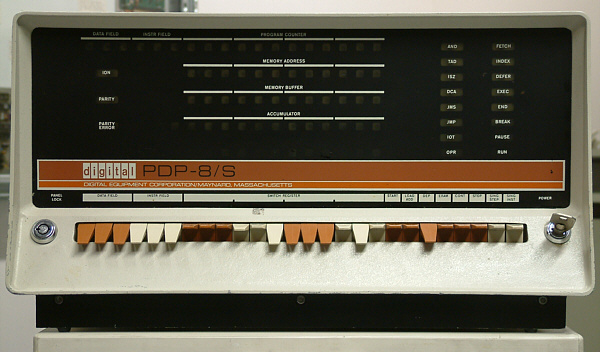PDP-8/S

<<< *** >>> ^^^
| Manufacturer: | Digital Equipment Corp. |
| Type: | PDP-8/S |
| Year: | 1967 |
| Serial no.: | 862 |
| Technology: | discrete transistors (R-Modules) magnetic core memory 4096W * 13Bit |
| Price: | below $10000.- |
The PDP8-Computer was the world's most common Microcomputer. It was designed with the goal in mind, to offer a computer for less then $10000. It is built with discrete transistors, the same technique as the classic PDP8, which also is a 2nd-generation computer. To keep the price down, the parts of the PDP8/S were designed bit serial. The ALU consists of a 1-bit adder, the datapaths between registers are also 1 bit wide. The memory with a word size of 12 bit + parity bit and the I/O-Bus, as well as the operation codes were implemented in parallel. Logic levels are 0V for logical 0 and -3V for logical 1.
As usual with new aquisitions in the museum it doesn't quite work yet, so we are busy with repairs.
Things are starting to look better: Except for minor glitches in the frontpanel the machine is up and running again and we are designing an interface for the Teletype.
PDP-8/S front panel detail

Detailed view of the front panel
Every instruction is decoded in hardware and indicated via a light. The lights to the right show the steps of executing the instructions. At the lower edge of the image one can see the labels for the switches that are used to manipulate and examine the contents of the main memory and to control the processor.
PDP-8/S Inside

A view inside the machine
If I didn't miscount, you can see 172 R-modules. That are logic modules with a complexity comparable to simple integrated TTL-circuits, for example four 2-input NANDs or two flip-flops.
The 35 white modules are mostly drivers and interface circuits. The two green quad-modules belong to the core which is located between them.
Six empty slots at the left side are for the I/O bus. The extension box which contains the peripheral interfaces, for example the TTY interface is connected with cables to these slots.
